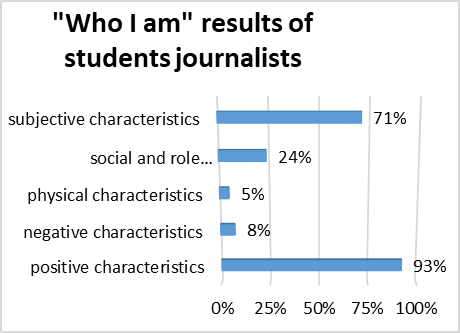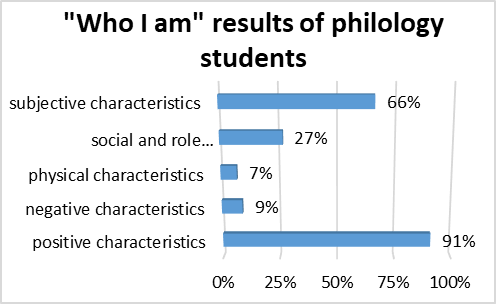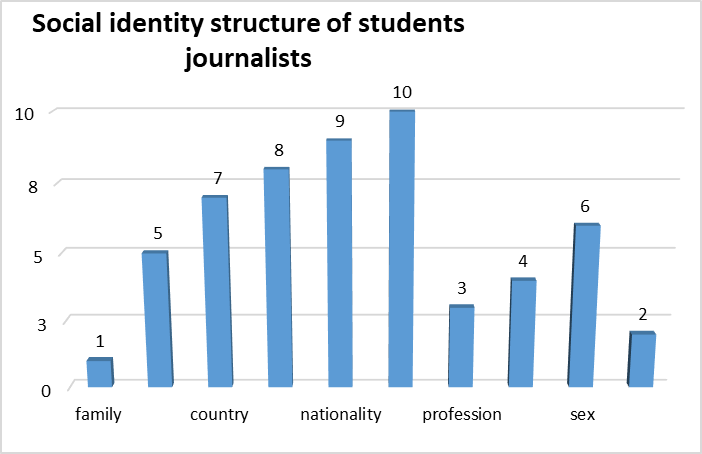Abstract
The specificity of identity in the modern changeable and uncertain reality is revealed. Various forms of transitivity - crisis and fluid, associated with different degrees of tolerance towards surrounding world are analyzed. The influence of the information space, primarily social networks, on the mental development and socialization of young people is considered. The results of empiric research of adolescents and young people showed that crisis, rigid transitivity affects all aspects of adolescent and youth identity. It is also shown that the positive parameters of self-description are not fully restored after the passage of the social crisis. At the same time, there is a clear tendency towards personalization for all groups of young people. The increase in the number of self-descriptions in the current situation of uncertainty testifies to the desire of young people to respond more flexibly to changes as well as to be more reflective. The fact that social transitivity, especially in its crisis version, is a difficult situation for socialization, clearly appears in the content of social identity, primarily in the increasing role of the family as a group of comfort and emotional support. The obtained results show that modern social networks have a significant impact on the self-image of youth, which is manifested in an increase in the “informational” self-descriptions in the content of personal identity. It is also proved that the trends in the formation of identity are common for young people with different professional identities.
Keywords: IdentitytransitivitypersonalizationInternetself-description
Introduction
Identity in modern transitive reality
When we discuss psychological nature of transitivity, we may state that it is connected with the multiplicity, variability and uncertainty of macro and micro social spaces. Multiplicity and uncertainty are not the only cause of troubles and psychological tensions. What's more important is people's relation to uncertainty due to their fears and anxieties of changes.
Modern space of people's life is rapidly changing. Meanwhile some "islands of stability" still remain. It means that in the situation of multiplicity and variability it is possible to define two related aspects or phases – hard, crisis transitivity and fluid, soft transitivity. At the same time, uncertainty, multiplicity and variability remain the dominates of the general direction of development of society, changing the degree of its cardinality.
Today we may note that liquid transitivity is characterized by slow, but constant changes in many aspects of life. That is the period of dramatic changes of 90's has been replaced by the period of slow and ongoing transformations. In the result changes become less dramatic but remain inevitable as it used to be 20 years ago (Martsinkovskaya, 2015).
From a psychological point of view, we can declare that critical, rigid transitivity is a shock situation for people. It submits increased demands on their resilience and emotional stability, rooted in the environment. But psychologically, the crisis is seen as a transient phenomenon that must be dealt with. It causes emotional distress here and now. This option of transitivity gives us hope that one has to survive negative situation, but after all everything will be fine again.
Therefore liquid transitivity becomes more severe from psychological point of view because in that way the crisis does not lead to a stable period, it leads to this type of transitivity. Everything changes: way if life, values, communication, information flow, technological environment of people. Meanwhile we start to believe that these changes are inevitable and unstoppable. Such long-term socio-cultural variability leads to the actualization of the desire for peace and stability. People are tired of uncertainty, transitivity, want to hide from it in everyday life, in the family, in a group of close values and aspirations of people (Vakhshtain, 2015; Orestova, 2017).
In this context, it is important to note that modern transitive reality can be considered as a complex, multi-dimensional space-time construct which psychological essence is associated with the subjective attitude to its components, expressed by human social and personal experience, as well as people's values and desires (Martsinkovskaya, 2017a).
Heterochrony concepts of this psychological construct are very important when we study strategies of self-development and self-realization in the modern transitive space. On one side the transitivity gives greater freedom and variability of surrounding world, such as language, wealth, living space, culture. On other side it brings anxiety and makes a person unable to maintain resistance to fundamental changes.
Mass media and the Internet as a new space for development
The studies of recent years prove that Mass media becomes one of the leading institutions of socialization (Belinskaya, 2013; Voiskounsky, 2010; Golubeva, 2015; Golubeva & Martsinkovskaya, 2011). At the same time over the past three years teenagers have become much more critical on information received from electronic media, mainly television. All means of information, such as advertising, entertainment, news, are regarded from the critical point of view. At the same time, trust in information received from the Internet has not decreased.
It is also important to note that for a large group of young people the Internet is not only a way to get amused, but it is a also a way to get information and even educate oneself. The share of television and print media is becoming significantly smaller in the information field of teenagers and schoolchildren especially compared to adults. Another significant study reveals various attitudes to the Internet among different generations, as well as people living in different social spaces. The data shows that adults pay more attention to TV programmes as a source of information and as a background, they also have much more trust in advertising and information received from TV than younger people. Verbal and visual information (movies, TV shows, books) are most important for adults. From other side young people get more interested in music which becomes both a common background for life and means of obtaining information about surrounding world (Golubeva, 2015, Grebennikova, 2015).
Problem Statement
The obtained data let us conclude that it is highly important to continue study of information socialization problem because it has great opportunities located in this field of institutions and groups of socialization impact. It is also important that different types of information can influence not only the lifestyle of young people, but also their ideas about themselves.
We assume that the active use of the Internet for communication and information leads to reassessment of reality, more precisely, to the emergence of a new view of the world.
Research Questions
Since over the past five years, Russian society has gone through several stages – from liquid transitivity to a crisis one, from crisis transitivity back to fluid one, it is important to study the following issues:
The change of youth identity content during transition from one stage of social transitivity to another.
Differences in the content of social and personal identity of young people with different professional identity.
Purpose of the Study
To identify differences in the content and structure of the young people's identity in the situation of transitivity of varying degrees of complexity
To compare the structure of social identity of modern teenagers and young people.
To study the personal identity content of students with different professional identity.
Research Methods
The questionnaire “Structure of social identity” (Martsinkovskaya, 2017b);
The questionnaire “Personal identity” (Martsinkovskaya, 2017b).
Participants
The survey was executed during 2013-2018.
120 pupils from the school LPG SOSH №806 participated in this survey in 2013, 2015, 2018.
120 pupils from the school LPG SOSH №806, 120 1st and 2nd year students participated in the survey in 2018. The first group – journalism students of the 1st and 2nd courses (n=52; 30 girls and 22 boys) aged 18 to 21 years (average age 19.5 years) The second group – students-philologists 1st course (n=50; 32 females and 18 males) aged 17 to 19 years (average age 17.9 years).
All the participants gave their consent to participate in the study.
Findings
Identity content study at different stages of social transitivity
As seen from Tab.
The teenager's identity content is dominated by personal characteristics (personal qualities, character traits, etc.). This component, along with the communicative and physical characteristics is 75% of all qualities. It refers to the individual characteristics of the individual. We may assume that the construction of personal identity is the age task of teens. This indicator is stable in relation to changes in the modern social context.
Meanwhile the data shows that the indicator of awareness of one's group affiliation is more sensitive to changes in the social context. In 2015, 24% of all characteristics refer to self-awareness through group membership, while in 2018 this figure is 33%.
It is important to note that in 2018 teenagers more often indicate themselves as belonging to the gaming community ("I'm a gamer", "I'm a doter", "I'm an invoker", "I'm a procaster", "I'm a cser"). We didn't meet it in 2013 and 2015. It proves that gaming space forms modern teenager's identity. The virtual space is "embedded" into the space of teenager's identity, which also confirms the fact of greater influence of the social context on the formation of teenager's social identity.
The results show that in the period of rigid and critical transitivity, all indicators of identity significantly change – from the number of self-descriptions to the ratio of positive and negative self-descriptions. The data reported in table
The study of student's identity
Similar results were obtained during the study of student's self-descriptions with different professional identities – philologists and journalists (Fig. 1 and 2).

Journalism students review analysis (n=52) in figure
The content of personal identity of journalism students is represented by the description of Hobbies, assessment of their abilities to various activities, description of acquired skills, experience. Respondents described their character features and style of behavior (impulsive, thoughtful, purposeful, impudent, rigid, etc.).
The content of social role-playing self-descriptions is mainly revealed through educational and professional affiliation (student; journalist, blogger, media marketer, SMM promoter, etc.). In addition, the study participants indicated their group affiliation in self-descriptions (instagram user, football fan, gym bunny). It is common when respondents mention their family status (daughter/son; wife; sister/brother, etc.). There are few cases of indicating citizenship and ethnic identity (Russian citizen, Armenian, Tatar, Russian).
Physical characteristics are presented by the description of anthropometric data and estimated judgments of appearance (long as a cross tie, fat, average height, blonde, etc).
In the group of philology students (n=50) (Fig. 2) the majority of self-descriptions refer to subjective characteristics that made 66% of answers from the total number (the average number of answers on this category 11,6). Socio-role characteristics accounted for 27% of the total number of responses (the average number of responses in this category is 4.78). Self-descriptions relating to physical characteristics accounted for 7% of the responses (the average number of responses in this category is 1.2). Positive self-descriptions (the average number of responses in this category is 15.9) far outweigh the negative characteristics (the average number of responses in this category is 1.7).

In that way the study of the identity's content characteristics in a transitivity situation showed that the changes are associated with a simultaneous increase of components included in the socio-cultural and group identity, and an increase of the importance of the personal component in the overall structure of identity. A strong desire for individualization is especially typical for younger respondents.
The results of "Who am I" method allowed to identify peculiar properties of the structure and content which belong to journalism and philology-student's identity. The answers of the first and the second group of respondents are characterized by a high level of reflection and positive attitude to themselves. It is worth to note that journalism students are peculiar for self-descriptions related to activity in the media and in the Internet (for example, "blogger, smm-manager, copywriter, etc.), unlike philology students who have no references to digital environment (writer, philologist, editor, etc.).
Social identity study of teenagers and students
The study of social identity structure helped to determine the importance of different social groups and their hierarchy. The results are shown in table
As one can see on the tab.
Similar results were obtained in the structure study of the student's social identity (Fig. 3 and 4)

Respondents put a family first with a significant gap with other priorities (2,67). Hobby (3,18) took the second place. Professional interests took the third one (4,17). Identification with generation (4.23) and humanity (4.81) is leading with a small lag among respondents. This is followed by gender-role identification (6,48). Almost equal positions belong to a native country (6,67) and a city (6,68). Nationality (7,19) and religion (8,31) are on the bottom of the list.
Answers of philology students have been ranked by using the method of studying the social identity structure. It allowed to identify priority areas: family, hobby, generation, profession, humanity, gender, country, city, nationality, religion.

Family (1,96) is the first priority of respondents. Hobby is on the second place (4,04). Generation is on the third place (4,4). Professional interests (4,46) and belonging to humanity (5,02) took the fourth place. Gender-role identification (6,28), identification with a nation country (of 6.78) and the city (6,88) are on the equator. Nationality identification (7,52) and religion identification (7,76) are on the bottom of the list.
The study of social identity structure has revealed that young people appreciate family and try to be in touch with family members. At the same time, they are focused on their personal and professional interests. They are interested in what is happening among coevals and all mankind, they are limited in lesser degree by the gender framework, borders of the country and native city. National and religious identity do not interest them. However, the importance of professional identity is higher among journalism students (4,17) in contrast to philology students, who rated higher belonging to generation (4,3). Ii is probable that in relation to religious philology students (7,76) show a greater tolerance to religion identity in comparison with students of philology (8,31)
Conclusion
7.1. Social transitivity makes special demands for the formation of personal and social identity. Rigid and crisis transitivity situation is the toughest one, it substantially reduces all the components of self-description: from the total number of self-descriptions to the ratios of positive and negative qualities in the content of identity.
7.2 The increasing number of personal characteristics in the content of teenager's identity emphasizes the trend towards personalization. It is typical for the current situation of the transitive and information space.
7.3 The increasing of number of self-descriptions can be seen as a desire of young people to flexibly react to changes and to be more aware of themselves. At the same time, the increasing number of characteristics associated with the information space proves that virtual identity starts to take bigger share of the overall content of both personal and social identity.
7.4 The need for emotional protection and comfort increases in rough and liquid situations, what makes family be more important in the structure of socio-cultural identity.
7.5 The transitive and informational spaces are connected according to the fact that information helps to create adequately position in a constantly changing, uncertain complex system, which is the modern reality. At the same time, growing role of the media, its transformation into one of the institutions of "liquid" socialization leads to anonymity and generalization of incoming information, which often leads to increased tension and emotional discomfort.
Acknowledgments
The study was supported by Russian Scientific Fund, project 19-18-00516.
References
- Belinskaya, E.P. (2013). Information socialization of adolescents: the experience of using social networks and psychological well-being. Psychological study, 6(30). Retrieved from http://psystudy.ru/index.php/num/2013v6n30/858-belinskaya30.html
- Golubeva, N.A. (2015). Features of informational preferences of modern pre-schoolers. World of psychology, 1, 153–163.
- Golubeva, N.A., & Martsinkovskaya, T.D. (2011). Informational socialization: the psychological approach. Psychological study, 6(20). Retrieved from http://psystudy.ru/index.php/num/2011n6-20/579-golubeva-marsinkovskaya20.html
- Grebennikova, O.V. (2015). Transformation of social representations in intergenerational interaction. Learning psychology, 3, 4–15.
- Martsinkovskaya, T.D. (2015). Modern psychology – challenges of transitivity. Psychological study, 8(42). Retrieved from http://psystudy.ru
- Martsinkovskaya, T.D. (2017a). Internal form of psychological hronotope: approaches to the problem. Psychological study, 10(54). Retrieved from http://psystudy.ru/index.php/num/2017v10n54/1448-martsinkovskaya54.html
- Martsinkovskaya, T.D. (Eds.) (2017b). Identity in everyday and transitive world. Moscow: MPGU Press.
- Orestova, V.R. (2017). Cinema and psychology of everyday life. Psychological study, 10(56). Retrieved from http://psystudy.ru.
- Vakhshtain, V.S. (2015). The case of everyday life. St. Petersburg: Center for Humanities Studies.
- Voiskounsky, A.E. (2010). Psychology and the Internet. Moscow: Acropolis.
Copyright information

This work is licensed under a Creative Commons Attribution-NonCommercial-NoDerivatives 4.0 International License.
About this article
Publication Date
14 July 2019
Article Doi
eBook ISBN
978-1-80296-063-1
Publisher
Future Academy
Volume
64
Print ISBN (optional)
-
Edition Number
1st Edition
Pages
1-829
Subjects
Psychology, educational psychology, counseling psychology
Cite this article as:
Martsinkovskaya*, T., Golubeva, N., Ayanyan, A., & Huzeeva, G. (2019). The Dynamics Of Identity In The Information And Transitive Space. In T. Martsinkovskaya, & V. R. Orestova (Eds.), Psychology of Subculture: Phenomenology and Contemporary Tendencies of Development, vol 64. European Proceedings of Social and Behavioural Sciences (pp. 356-364). Future Academy. https://doi.org/10.15405/epsbs.2019.07.46
